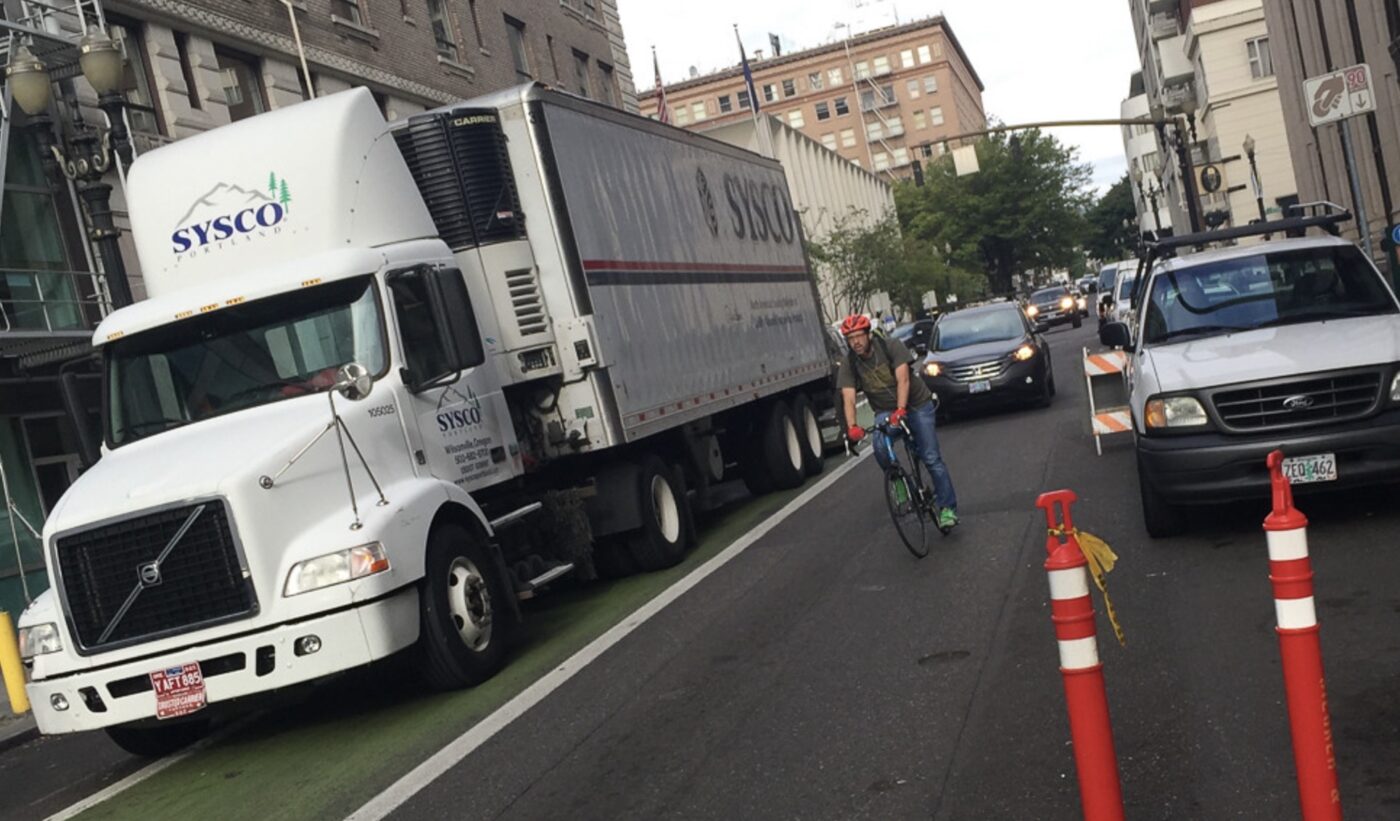
The Portland City Council is poised to pass a new freight master plan at their meeting Wednesday — a step that comes more than three years after the Portland Bureau of Transportation launched the effort. The new plan, 2040 Freight, will update the existing plan that council adopted in 2006.
We watch freight advocacy and planning closely because of the very tragic record of cycling deaths that have involved trucks and their drivers — as we saw most recently last October when Sarah Pliner was killed in a collision with a semi-truck while trying to cross Southeast Powell at 26th. Portland’s freight advocates have also influenced many bike infrastructure projects over the years. It was taxes paid by truck companies that helped get the separated bike path on North Greeley Avenue built, and it was the Portland Freight Committee (PFC) that opposed the addition of bike lanes to North Lombard (thankfully they got put in anyways).

With the 2040 Freight Plan, the Portland Bureau of Transportation will have an updated guide to manage the freight system and a good opportunity to refresh its freight committee. Unlike PBOT’s bicycle and pedestrian advisory committees, members of the PFC have been able to far exceed term limits. In 2017, in an effort to rebalance and diversify all of its advisory committees, the City of Portland set new term limit rules for advisory committees. This led to several senior members of the Bicycle Advisory Committee having to leave against their will. But when some veteran PFC members pushed back on the new rule, former PBOT Commissioner Chloe Eudaly gave them a special dispensation: They could remain on the committee in order to develop the 2040 Freight plan. Now that it’s completed, it will be interesting to see whether current PBOT Commissioner Mingus Mapps follows through with city policy and makes the PFC recruit over a dozen new members.
It is patently unfair to require the bicycle and pedestrian committees to welcome new members while allowing the freight committee to retain veterans. This has given freight interests a major advantage when it comes to influencing PBOT policies and projects.
Thanks for indulging that little digression… let’s get back to the 2040 Freight plan.
Like other modal plans, PBOT is required by law to have one on the books. The plan does several things: it lays out a framework for making policy and project design decisions, it helps PBOT compete for grants (being able to say, “Xyz project is in our freight plan” helps a project score better), it includes a prioritized list of infrastructure projects, sets freight-related street classifications, and helps give city planners and advocates a deeper context for how the movement of freight fits into the transportation system.
Part of the new freight plan looks to correct past mistakes in how we understand its role. Instead of seeing “freight” as large trucks and a mode of travel alongside “bicycle,” “pedestrian,” and “single occupancy motor vehicle,” PBOT says that framing “fundamentally mischaracterizes it as a mode.” Instead, PBOT sees freight as a system where many different modes work together.
For instance, if the distance is short and the package is light, PBOT says the best freight vehicle would be feet (see graphic at right). For slightly longer trips and heavier packages, an electric bicycle might be the recommended vehicle.
A key takeaway from 2040 Freight is that PBOT wants to get smarter about how the land use and urban design context dictates freight movement.
Right now, the balance is off. Currently the plan states that about 75% of freight movement in the Portland metro area relies on trucks. That means the negative impacts of those trucks — diesel emissions, noise, traffic safety concerns, etc. — has significant impact on our roads and residents. And Multnomah County research shows neighborhoods with a majority of Black, Indigenous and other people of color are exposed to those externalities at two-to-three times the rate of the average Portland-area resident.
And with heavy trucks accounting for about 15% of the total diesel emissions in Portland, you can see why PBOT wants to make freight movement cleaner. Their downtown zero emissions delivery zone is one step they’ve already taken. A different mix of delivery vehicle types will also help.
Smaller and cleaner vehicles will not just help with air quality, they will also free up valuable space at the curb and other congested areas as well as reduce injuries and deaths from traffic collisions.
In the safety section of the plan, PBOT says most freight truck collisions happen at intersections, therefore, “Implementing safety countermeasures for vulnerable users, such as separated facilities for bicyclists, clear signage, or providing for alternate parallel routes will improve safety…”
The plan should help spur more physically separated cycling infrastructure. In a section that defines the “Industrial Roads” street classification, PBOT states, “Pedestrian and bicycle crossings should be grade-separated or signalized, and pedestrian and bicycle facilities should be separated from motor vehicle traffic.”
One of the most important parts of the plan is the list of projects. There are 55 projects in the plan worth over $812 million — 14 of which ($265 million worth) are identified as “high priority.” (Note: The plan does not allocate any money to these projects. It is just a list of estimates for planning purposes)
Most of the high priority bridge and highway projects in the plan are located along Columbia Blvd. Two projects totaling $14.5 million along the popular NE 33rd Avenue bike route would include cycling safety updates at Lombard and Marine Drive.
Also notable is that both 33rd Ave (between Columbia and Marine Drive) and Marine Drive (between 33rd and I-205) will be changed to a higher freight street classification in the Transportation System Plan (TSP). These classifications are very important because they dictate what type of cross-sections and design treatments are feasible.
This section of NE 33rd will become a “Major Truck Street” in order to, “recognize the importance of this street for freight movement flow in/out of key origins/destinations within the Freight District.” And Marine Dr will go from Local Service Truck Street to Freight District Street.
These changes reflect PBOT’s desire to “unlock” adjacent industrial areas and make them more freight-friendly. Will it come at the expense of safe cycling infrastructure? That remains to be seen, but it certainly gives freight advocates a leg up in future debates.
Several other projects and policies in the plan have significant cycling impacts. We’ll be covering them as they develop in the months and years to come.
City Council will take up the resolution to adopt the plan at their meeting on Wednesday July 12th at 2:00 pm.
— 2040 Freight on Portland.gov.
.



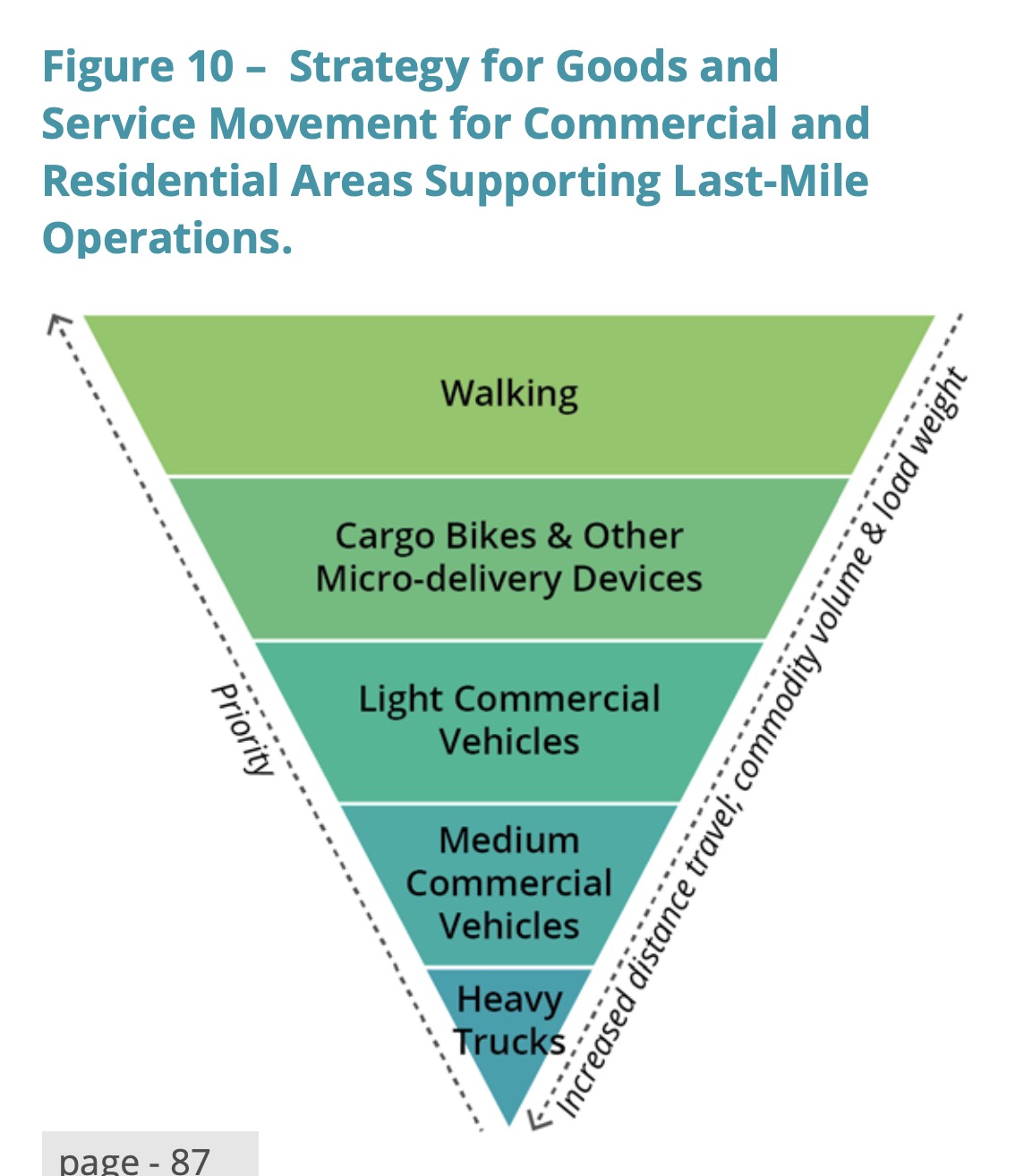
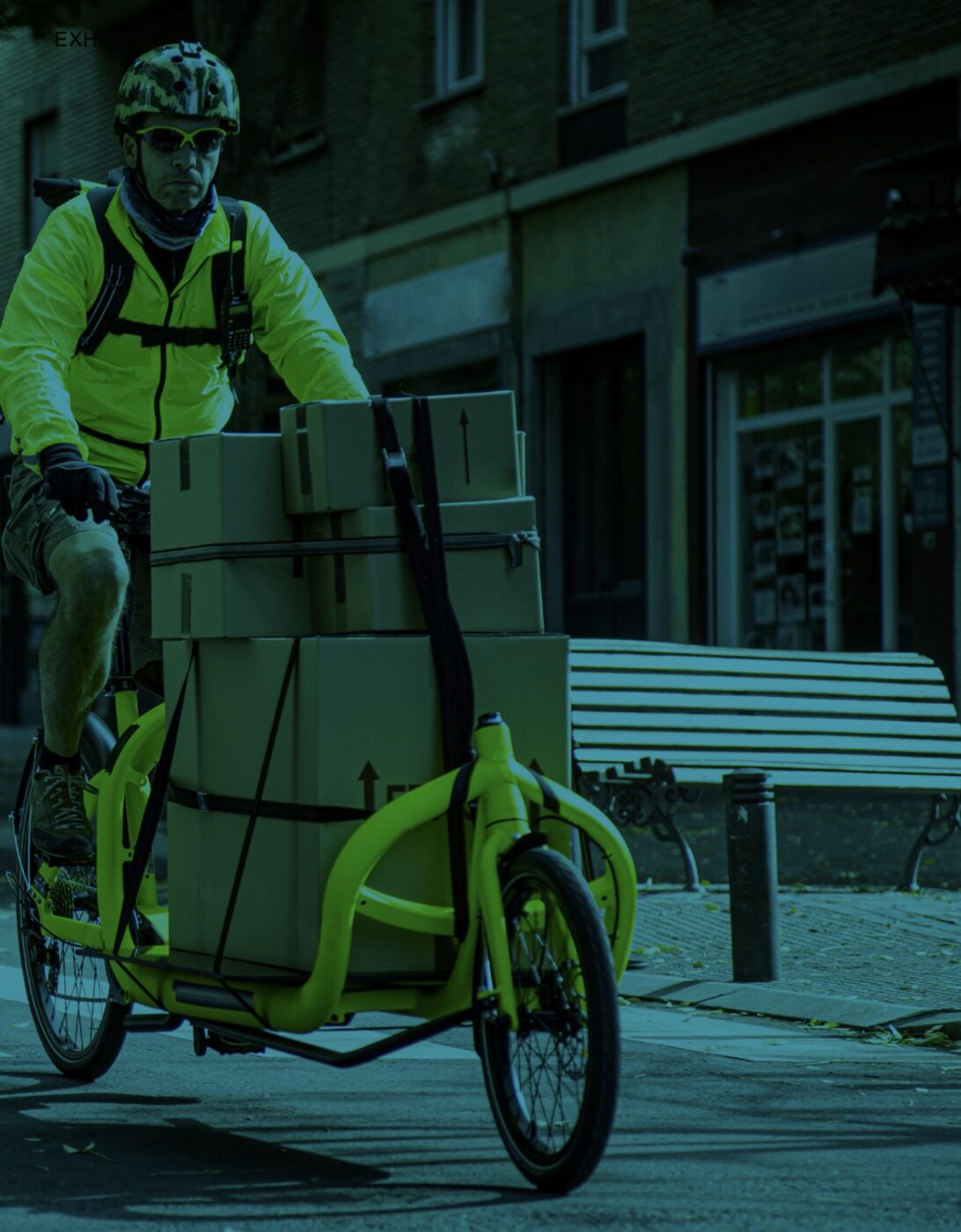
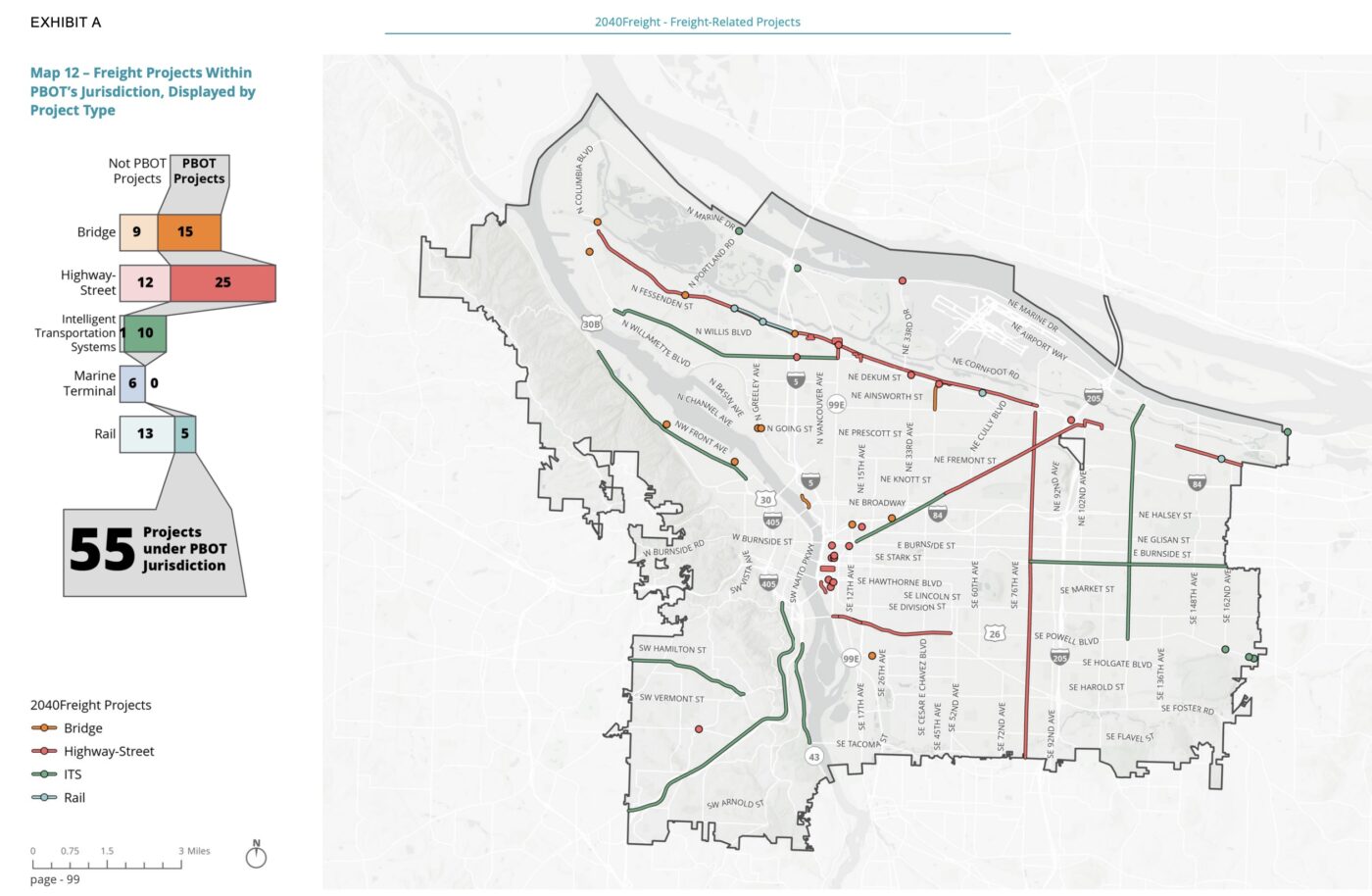
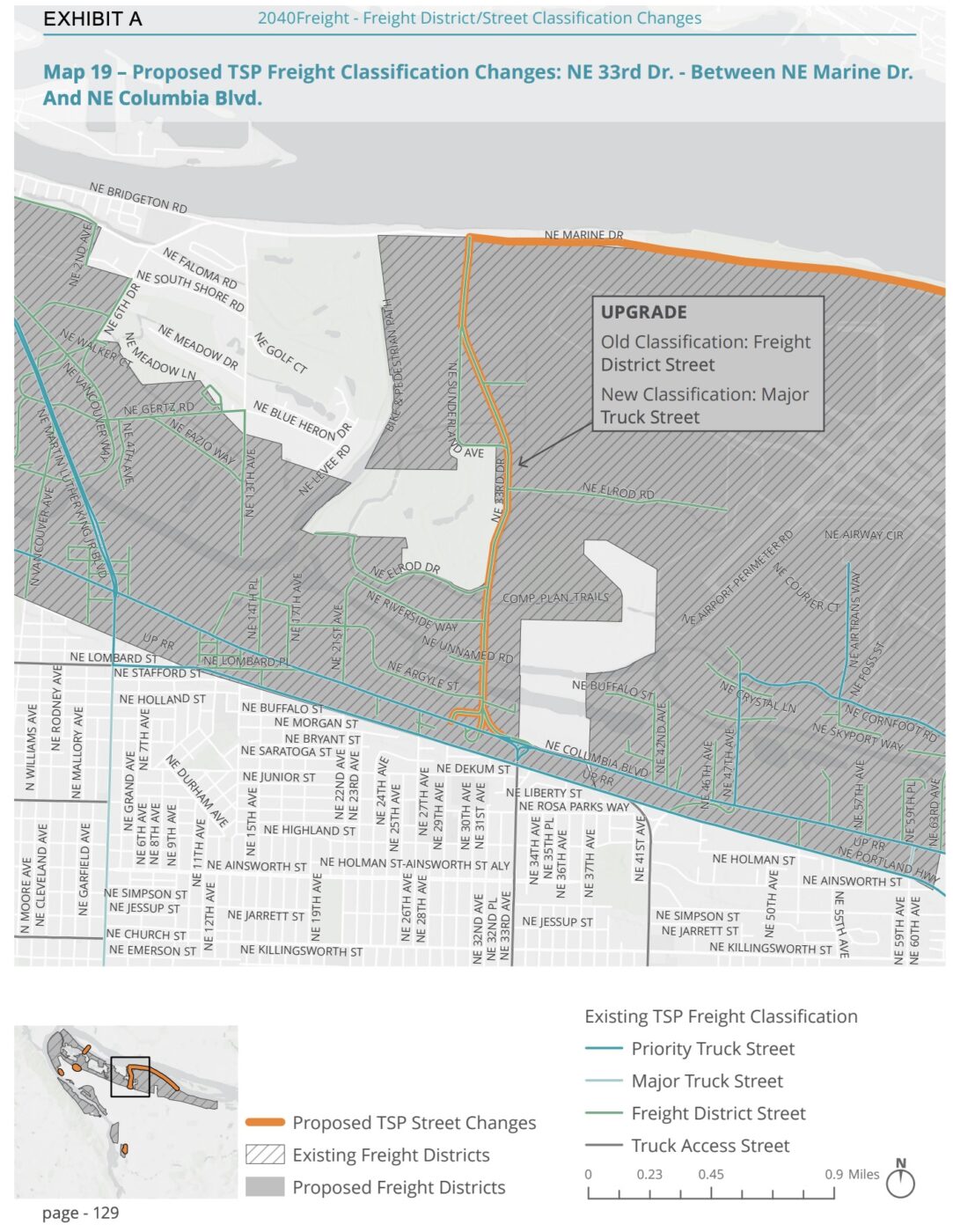


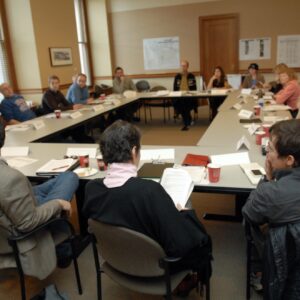

Thanks for reading.
BikePortland has served this community with independent community journalism since 2005. We rely on subscriptions from readers like you to survive. Your financial support is vital in keeping this valuable resource alive and well.
Please subscribe today to strengthen and expand our work.
Disclaimer: I don’t know what I’m talking about.
My initial thought about the Marine Drive changes is that it seems like it wouldn’t matter a whole lot since that path is completely separated from the roadway, but it could make the crossings more dangerous so they might need to change the pedestrian blinkers into an actual red light that stops traffic explicitly instead of just warning drivers.
I do have some concern that it would lead to an increase in heavy trucks on the western “bike lane” section of Marine Drive leading up to the separated path. I can see that the idea is for the trucks to approach from 33rd instead but some won’t and that section is already scary with passenger vehicles passing at speed and a skinny bike gutter that becomes even more narrow around turns.
It is odd – and often really tragic – how often Portland regional planners require bikes to share space with cars and trucks. “Just press that there button and those nice drivers will see you and stop for you.”
In other parts of the country, planners rightly realize that cars and trucks are really dangerous and their operators are often drunk, high, angry, or distracted (or all four at once), so they make no pretense of ever relying on their goodwill: any bike lane or path will be well off the road and will *never* cross at grade and require a beg button and “advisory” signals – they would simply mean death for cyclists.
I do have to say that Portland drivers are far nicer to cyclists than drivers in other parts of the country. Unfortunately, the percentage of dangerous drivers going from 10% in my old Midwest city to 2% in Portland still doesn’t change the need for full protection, because it only takes one dangerous driver to kill you.
(Those percentages are not real statistics, I just made them up based on my totally subjective feelings from comparing two cities I’ve lived in.)
To get to Blue Lake on Marine Dr., you pretty much have to ride on the shoulder. There are some poorly maintained sections on the south side that no one rides, but those aren’t appropriate for someone going out for a long ride into the Gorge. A solid separated bike lane on Marine drive would be world class biking infrastructure. The view of the river and the mountain as well as the flat miles shouldn’t be wasted on freight alone.
Went for a couple of rides in the area over the 4th of July holiday weekend:
So I’m certainly apprehensive about the freight committee (and things can always get worse) but I feel like this is generally positive news that I’ll be following (as I imagine it will take years) for anything to happen here.
I wonder how much of this work is going to be seen as a 2 for 1 by the city as they can also do camp sweeping (pushing the problem somewhere else) and install infrastructure hostile to people camping like they did up on North Whitaker Road by lowes.
Is there any way to get to the Marine Drive path that doesn’t involve dangerous traffic like that? I really don’t care about anything other than the situation you described. I took my kid for a ride a few weeks ago and came from the Delta Park area because I knew the route to get there and it looked ok. But somewhere on Marine Drive before you get to the separated bike path, it got really bad. The maps indicate this is a real bike lane but it was hell. The path was overgrown by like two full feet in many parts so I couldn’t get that far over with a trailer in tow. As it happened, another cyclist passed and then came back and offered to ride behind me for the short remainder of distance to 33rd.
I think it wouldn’t be so bad by myself without a trailer (although still not nice). I’d really like to go back but that way to get there was horrible and I don’t think I’ll be doing it again with my kid. 33rd is how I got home, and that didn’t seem too bad, but I just wonder if there is any better route.
I’m also concerned about up-classifying Marine Drive. IMHO, Marine Drive should be classified as a greenway, Scenic Route, or some other type of low speed street. Faster, confident riders sometimes avoid the path because of congestion, slower riders, walkers with dogs, etc. With the boat ramp, marinas, scenic views and other recreational opportunities in that area, we should be working to keep it as a street for people. There is already some friction with truck traffic; as long as the airport is operating, there will be folks who drive at or below the speed limit to watch the planes…much to the angst of truck drivers.
I also wonder how much “industrial land” is developable in the Marine Drive/NE 33rd zone. Much of it is wetland or under FAA restrictions for use types and heights. The former golf course at NE 33rd and Columbia had a substantial amount of wetland on it’s northern half, and as part of it’s redevelopment had to enhance and preserve the wetlands as mitigation for the Amazon/ProLogis development at Portland Meadows.
We’ve played a role in moving product since 2009 without any diesel or petrol within PDX. And while we’re not an economic engine like Amazon or whatever, the importance of cargo bicycles as legitimate tools for commerce should be mentioned and marketed early and often.
Thanks for sharing Johnathan. I was reading into some of the plan details and one of the medium priority projects relevant to cyclists is the Sandy Blvd Corridor Improvements. The scope of the project is from 47th to 110th street. The description says:
I’m not sure what the extent of the bicycle facilities could be, but the estimated cost for the project is $6.5million. It would be great to see this stretch of Sandy with bike lanes. I just hope I won’t have to wait until 2040 to see it happen.
Contrast that with the $150 million 82nd Avenue project in the FMP:
Note no mention of freight movements, unlike Sandy. Is freight abandoning 82nd as a major freight corridor? Or at least down-grading its importance? If 82nd is forced into a road diet, has the FMP declared “no contest” as far as its opposition?
It’s important to not only read into a plan what it does say, but also what it doesn’t say. The total failure of the BMP 2030 was not that wasn’t detailed enough for the nice inner areas of town, but for the very obvious lack of detail for the bad parts of town – that if you happened to be poor and living in East Portland or in Southwest, you were screwed because the BMP 2030 only advises safe infrastructure every half-mile for the outer parts rather than every quarter-mile for the inner parts of Portland. From a social equity point of view, it should have been the reverse. In other words, it was a failed plan from the get-go. And that failure lead directly to the EPIM and all the subsequent In-Motion plans.
So a question remains, is this new FMP totally flawed from the get-go or does it stand a chance of actually being implemented in any meaningful way? And is PBOT actually capable of producing an implementable master plan at all or will it too be abandoned in favor of a freight-in-motion-plan (FRIMP) and other ad-hoc policies and plans?
Cool it will just be like the 2030 bike plan but actually happen
The 2030 bike plan was an unfunded joke from the very beginning. The inability of cycling enthusiasts to understand that Portland’s aspirational “plans” are designed to fob off activist subcultures is hard to understand.
So, winding “”””parallel”””” bike routes. Cool.
AKA Expensive, inaccessible pedestrian bridges with elevators that are always broken.
That second part seems relevant.
Two things among several positives stand out to me: 1) the acknowledgement that truck traffic can be especially dangerous for people walking and biking, and 2) that biking and walking are part of the delivery system of goods and services.
One thing that means in particular to me is how wrong the “bike riders should pay for bike lanes” idea is.
If trucks are contributing to making biking and walking more dangerous, then it doesn’t make sense to say bike riders should pay for facilities to protect them from that.
And pointing out that biking and walking are part of the delivery system (and needed to make it efficient) is a reminder that biking and walking are serious modes of travel.
“It is patently unfair to require the bicycle and pedestrian committees to welcome new members while allowing the freight committee to retain veterans. This has given freight interests a major advantage when it comes to influencing PBOT policies and projects.”
I would think that the committee is best served by whomever has the most experience to bring to bear on the policy analysis. Bikes, Peds or freight interests should be free to select whomever they assess will represent them best. Why look for petty things to squabble about?
Thanks for the comment Gregg. Notice by a careful reading that my beef here is that the City created a new law and only enforced it against the bike and ped advisory committees. That is unfair and should never have happened. It creates an imbalance of power that results in less-experienced people advocating for bike/ped and furthers the already systemic political/institutional biases freight has. I support having new faces and voices on these committees because we need fresh perspectives and a wide variety of lived experiences to do this important work. It is nothing but special treatment and political favoritism – and a solid dose of the typical bullying of PBOT some freight committee members are infamous for — that has held the freight committee to a different set of rules.
Also… of course it seems “petty” to you because your interests benefit from the way things are!
I sincerely hope Mapps addresses this and if he doesn’t, I’ll look forward to debating it more with you in the comments of my forthcoming op-ed where I really lay out why this bothers me so much!
It’s PBOT that is willfully violating city law but somehow your ire is directed at anyone or anything other than PBOT. What does this say about the oh-so-cozy relationship cycling journalists (and cycling activists) have with a transportation org that has utterly failed to effectively promote cycling?
PBOT knows.
Yes I’m aware that PBOT is violating their own rule. Why are you trying to say I’m not directing ire at them? And you can save your bullshit about me having a too cozy relationship w PBOT. local transpo orgs, sure… but I have a very healthy distance from them (and everyone on this town for that matter) and I always put the community interest in front of PBOT comfort.
If you have any actual evidence or specific example of your implications please do share so i can address them!
I can’t remember the year, but at some point the US Justice Dept came down hard on the City of Portland (as a government body) for being a systemic racist entity, not just in the police and fire departments hirings, but even on the membership of city commissions (committees) such as the planning, bike, ped, and freight committees along with most others in other bureaus. The city then was required to produce and eventually implement a diversity plan. This is part of the result. It’s always a bumpy ride with lots of inconsistencies – let’s face it, some commissions are more racist than others, just as some bureaus are more likely to cave in to institutionalized and systemic racism than others. We aren’t there yet, we still have a ways to go…
One can argue that the Freight Commission may feel more powerful by having a cadre of long-experienced members and that they can dictate terms to PBOT – but the flip side is that they are seen by the public as more blatantly racist in their membership and seem to enjoy wallowing in their systemic racist mud – like piggies in their starched-white shirts.
First you say, “Bikes, Peds or freight interests should be free to select whomever they assess will represent them best.”
Then when Jonathan writes that it’s unfair to allow that for freight but not biking or pedestrian interests, you say, “Why look for petty things to squabble about?”
Which is it? You can’t have both. If your first statement is true, then it’s not petty to point out that only freight interests get that advantage.
My takeaway from your comment is that if freight wants that advantage, it’s important, but if someone points out that biking or pedestrian interests don’t get that advantage, then that’s being petty. Is that accurate? It’s basically exactly what you said.
Rules for thee and not for me.